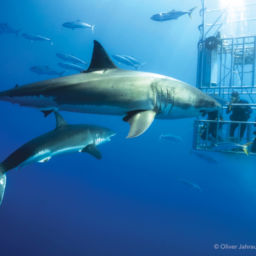Although interacting with the great white sharks of Guadalupe isn’t technically a dive experience, it does require breathing through a regulator that’s attached to a main air tank on the dive boat. Participants don’t need scuba certification to take part. I am, of course, talking about cage diving with great whites, in what many consider the world’s premiere location to do so. Cage diving is a controversial subject in the dive community, as is the chumming that accompanies it, but Mexico’s Guadalupe Island is so remote that there are no impacts on other human ocean goers and very little on the resident population of great whites. So if coming face-to-face with one of nature’s most iconic apex predators sounds appealing, this is undoubtedly the most ethical way to do it. It’s also the most rewarding, because Guadalupe’s location 250 miles off the coast of Ensenada on the Mexican Baja California coast almost guarantees crystal-clear visibility. The island is uninhabited save for the families of a handful of fishermen, and the sharks that live in its waters are some of the largest in the world, reaching lengths of up to 20 feet. Guadalupe’s resident population of elephant and fur seals, who enjoy protected status, are the main draw for the sharks.
[flo_gallery type=”single” name=”great-whites-guadalupe” id=”8581″ ]
Meeting the Great White Sharks of Guadalupe
Getting to Guadalupe takes some time, 18 hours from Ensenada on an overnight voyage. The journey is well worth it, however, and because the island is so far away from the mainland, trips to see the sharks of Guadalupe are only via liveaboards, which offer more time in the water than the day trips of other white-shark destinations. Within moments of sunrise, the heat will have you desperate to get in the water; and when the silhouette of the first shark moves beneath the boat like a shadow, you’ll know it’s time. Shoals of blue runners and fusiliers dart to-and-fro in front of the cage, and the sunlight spears through the water in shimmering shafts. Then, looking down, you’ll see your first shark, so perfectly camouflaged against the darkness of the depths that only the bright white of the scars criss-crossing her back make her visible. As she ascends gracefully through the water column towards the proffered tuna head, you’ll find yourself mesmerized by her power, but also by her calm serenity. This shark is nothing like the savage killer so often portrayed in film, instead she is something to be revered and respected, rather than feared.
More sharks appear, circling sedately around the cage, occasionally lunging lazily for the bait that is almost always kept just out of their reach. Rather than feeding the sharks, the crew expertly uses the bait to hold their attention and keep them in sight. The sunlight dapples their broad backs with a filigree of gold. They are impossibly long and girthy, yet they move through the water like ballet dancers across a stage. It seems that no amount of time in the water with them is enough. They come close to the cage, sometimes with their mouths agape and their coal black eyes rolled backwards to expose the whites of their nictitating membranes as they snap at the tuna heads, but not once will you feel threatened; the white sharks are supremely unconcerned about the humans in their little cage. It’s experiences like these that will change the world’s opinion of this species, which is why I challenge even those afraid of sharks to take this small step into their realm. There is certainly no better way to encounter them for the first time than with the added reassurance of the cage bars — you may even find yourself wishing you were on the other side.


